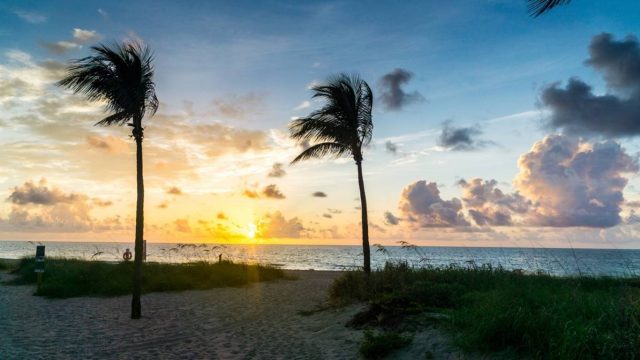
With sustainable travel and eco-friendly options becoming bigger drivers in terms of where Canadians decide to visit when on vacation, VISIT FLORIDA is highlighting some of the many places to stay, dine and explore where being green is taken to heart:
Ocala/Marion County: Home to the stunning Silver Springs, one of Florida’s very first tourist attractions and now a state park managed and protected by the State’s Department of Environmental Protection, downtown Ocala is also where you’ll find the Ocala Wetland Recharge Park, a new (Sept. 2020) green space that focuses on both environmental sustainability and education. The park is a 60-acre wetland ecosystem designed to reduce pollution in filtered storm water and treated wastewater, and the polished water recharges the Florida aquifer with approximately 3 million gallons daily. This incredible park is open to the public and offers more than four kilometres of walking paths, boardwalks and more to explore. As the park is relatively new, more and more wildlife are settling in to make it their home. Visitors may see fox squirrels and birds like ducks, great blue herons, egrets, hawks and more.
Jacksonville: Home to more than 12 farmers markets, Jacksonville is also where you’ll find Congaree and Penn – a critical link to the growing local food and drink scene and dubbed “the poster child for sustainable agriculture” that supplies several local, farm-to-table restaurants in the city with fresh produce. Some of the city’s top farm-to-table restaurants includes Orsay, 904 Restaurant, Black Sheep Restaurant, Kitchen on San Marco, and Moxie Kitchen & Cocktails. When it comes time to work off all that good eating, Jacksonville is home to the largest urban park system in the U.S., including seven state parks and two national parks.
Kissimmee: Offering easy access to Shingle Creek, the headwaters of the Everglades, visitors can take guided eco-tours via kayak, canoe or paddleboard, led by certified guides, and get an up-close look at the beautiful landscape and riverbanks visited by local fauna, including turtles, wading birds and alligators.
Lauderdale-by-the-Sea: Despite this town’s small size (just 6,000 residents and 3.8 sq. kms), it has taken on a “go big or go home” approach when it comes to environmental sustainability. It’s no surprise, Lauderdale-By-The-Sea is Florida’s Beach Diving Capital. It’s also a popular snorkelling spot. Snorkellers are always surprised at the abundance of sea life they see on the reef that is located just 100 metres off the beach throughout most of the length of the town. This is in large part due to the concerted conservation efforts that have been, and continue to be, made by the town. This includes the Staghorn Coral Project, now in its 6th year; the planting of more than 200,000 sea oats on the town’s beaches, which has been completed over the past five years by a dedicated team of volunteers; the Broward County Sea Turtle Conservation Program; the Butterflies by the Sea program that encourages residents to plant butterfly gardens, and much more.
Tallahassee: With its myriad outdoor offerings, this northern Florida city offers lots of sustainable (and socially distanced) activities that visitors can enjoy. Located in one of the most biologically diverse regions in the U.S., Tallahassee is home to more than 1,125 kilometres of trails – aptly lending the nickname “Trailahassee” – with abundant biking, hiking, paddling and running trails on a diverse topography unlike anywhere else in the State. And to when you are looking to get fueled up before heading out, local café RedEye Coffee provides bird safe, organic coffee and tea bought from small farmers at a fair price through certified organic cooperatives.
Martin County: Encompassing the communities of Port Salerno, Stuart, Palm City, Jensen Beach, Indiantown, Jupiter Island, Hobe Sound, Sewall’s Point, Rio and Hutchinson Island, Martin County serves up more than 35 kilometres of beautiful, uncrowded beaches and over 100,000 acres of parks and conservation lands – not to mention the most bio-diverse lagoon ecosystem in the Northern Hemisphere, the St. Lucie Inlet. The unique collection of diverse natural wonders offers visitors a range of under-the-radar but unforgettable eco-friendly adventures and experiences. When it comes to dining, check out District Table & Bar in Port Salerno, where eco-friendly practices are woven into virtually every aspect of this upscale restaurant (think locally sourced ingredients, an on-site garden, sustainable solutions to mitigate food waste, and participation in the Florida Oceanographic Oyster Restoration Program, a green initiative that works with local restaurants to collect oyster shells that would typically be thrown away and instead used in oyster reef restoration and oyster gardening to benefit the local waterways).
Florida’s Adventure Coast: Contrary to a popular belief held by many, Florida’s largest attraction isn’t a theme park, but rather its natural resources. On Florida’s Adventure Coast – Brooksville-Weeki Wachee – travellers are captivated by the trails, springs, rivers, forests and wildlife. From extensive trail systems, perfect for hiking and biking, to unspoiled lakes and rivers, along with ample opportunities for bird and wildlife watchers with two habitat clusters of the Great Florida Birding Trail nearby, experiencing the great outdoors is easy here.
For more information and inspiration for your next trip to the Sunshine State, head to VISITFLORIDA.com.





